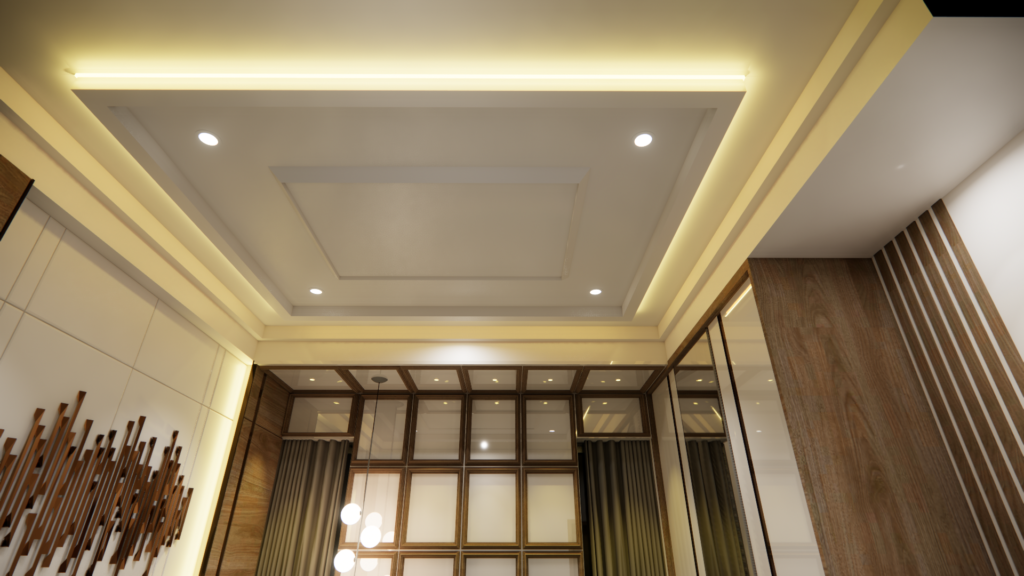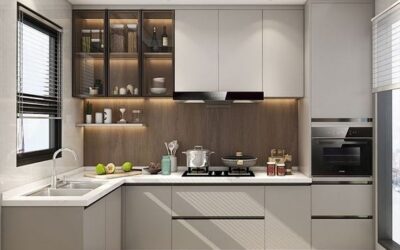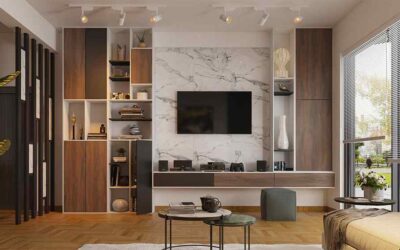- False ceilings, also known as dropped or suspended ceilings, are secondary ceilings suspended below the main structural ceiling of a room.
- They serve various purposes, including aesthetic enhancement, concealing infrastructure, and improving acoustics. There are several types of false ceilings, each with its own characteristics and applications. Here are some common types:
- Gypsum board false ceilings, also known as drywall or plasterboard ceilings, are a popular choice in interior design and construction. Like any construction material, they come with their own set of pros and cons. Here’s an overview:
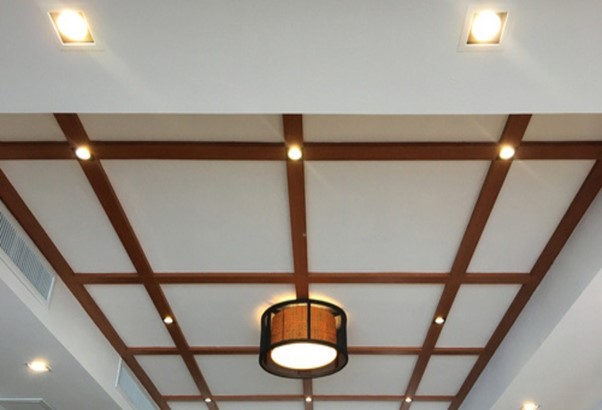
Table of Contents
Source – strattondesigngroup.com
Pros of Gypsum Board False Ceilings:
- Versatility:
- Pro: Gypsum boards are versatile and can be easily cut and molded to create various shapes and designs. This makes them suitable for a wide range of aesthetic preferences.
- Ease of Installation:
- Pro: Gypsum board ceilings are relatively easy to install, which can save time and labor costs during construction or renovation projects.
- Affordability:
- Pro: Gypsum boards are generally cost-effective compared to some other ceiling materials, making them a budget-friendly option for many projects.
- Smooth Surface:
- Pro: Gypsum boards provide a smooth and uniform surface, creating a clean and finished look when properly installed and finished.
- Fire Resistance:
- Pro: Gypsum boards have inherent fire-resistant properties, which can contribute to the overall fire safety of a building.
Cons of Gypsum Board False Ceilings:
- Susceptible to Moisture:
- Con: Gypsum boards are not suitable for areas with high moisture levels, as they can absorb moisture and become damaged. In such areas, water-resistant gypsum board or alternative materials may be necessary.
- Not Load-Bearing:
- Con: Gypsum boards are not designed to bear heavy loads. Care must be taken during installation to ensure proper support for any additional fixtures or equipment.
- Not Ideal for Outdoor Use:
- Con: Gypsum board false ceilings are not suitable for outdoor applications due to their vulnerability to weather conditions.
- Prone to Physical Damage:
- Con: Gypsum boards can be easily damaged by impact or pressure. In high-traffic areas or places where there’s a risk of physical damage, additional protective measures may be needed.
- Limited Thermal Insulation:
- Con: Gypsum boards have limited thermal insulation properties. In spaces where thermal insulation is a priority, additional insulation materials may be required.
- Not Environmentally Friendly:
- Con: The production of gypsum board involves energy-intensive processes, and the material itself is not considered highly eco-friendly. However, there are eco-friendly gypsum board options available.
Metal False Ceiling:
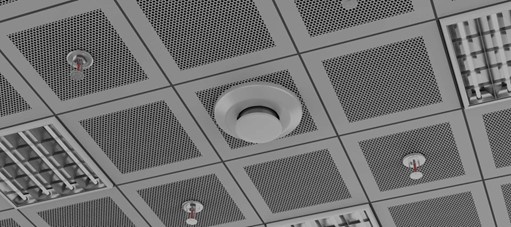
Source – strattondesigngroup.com
- Description: Metal false ceilings are made of materials like aluminum, steel, or tin. They are durable, fire-resistant, and provide a modern, industrial look.
- Applications: Often used in commercial and industrial settings.
Pros of Metal False Ceilings:
- Durability:
- Pro: Metal false ceilings are highly durable and resistant to wear and tear. They can withstand impact and are less susceptible to damage compared to some other materials.
- Fire Resistance:
- Pro: Many metal false ceiling materials, such as aluminum and steel, are inherently fire-resistant. This contributes to the overall fire safety of a building.
- Low Maintenance:
- Pro: Metal false ceilings are relatively low-maintenance. They do not require frequent painting or finishing, and they are easy to clean.
- Modern Aesthetic:
- Pro: Metal ceilings provide a sleek and modern aesthetic, making them suitable for contemporary design schemes. They are often used in commercial and industrial spaces.
- Variety of Finishes:
- Pro: Metal false ceilings are available in a variety of finishes, including powder-coated, anodized, or laminated surfaces. This allows for customization to match the design requirements.
Cons of Metal False Ceilings:
-
- Cost:
- Con: Metal false ceilings can be more expensive than some other materials, which may impact the overall project budget.
- Installation Complexity:
- Con: Installing metal false ceilings can be more complex than some other ceiling types. Professional installation may be required, adding to the overall project cost.
- Limited Thermal Insulation:
- Con: Metal ceilings have limited thermal insulation properties. In spaces where thermal insulation is crucial, additional insulation materials may be needed.
- Susceptibility to Corrosion:
- Con: Some metal materials, especially in humid or corrosive environments, may be susceptible to corrosion over time. Proper coatings or treatments can mitigate this issue.
- Weight:
- Con: Metal ceilings can be heavy, and the ceiling structure must be designed to support the additional weight. This may require reinforcement or additional structural considerations.
- Cost:
Wooden False Ceiling:
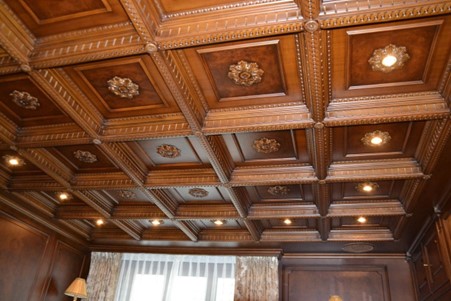
Source – strattondesigngroup.com
Description: Wooden false ceilings add a natural and warm aesthetic to a space. They can be crafted from various types of wood, offering versatility in design.
Applications: Often used in residential interiors, restaurants, and spaces where a classic or rustic look is desired.
Pros of Wooden False Ceilings:
- Aesthetic Appeal:
- Pro: Wooden false ceilings provide a warm and natural aesthetic that can enhance the overall look and feel of a space. They add a touch of sophistication and can complement various interior styles.
- Variety of Wood Types:
- Pro: There is a wide variety of wood types and finishes available, allowing for customization to match different design preferences and themes.
- Customizable Designs:
- Pro: Wood is a versatile material that can be easily shaped and customized to create intricate designs and patterns, offering a high degree of design flexibility.
- Acoustic Properties:
- Pro: Wood has natural acoustic properties, which can contribute to sound absorption and create a more comfortable acoustic environment in the room.
- Insulation Properties:
- Pro: Wood has inherent thermal insulation properties, providing a natural barrier against heat transfer and helping to maintain a comfortable indoor temperature.
Cons of Wooden False Ceilings:
- Cost:
- Con: High-quality wood can be more expensive than other false ceiling materials, which may impact the overall project budget.
- Susceptibility to Moisture:
- Con: Wood is sensitive to moisture and humidity. In damp environments, it may warp, swell, or become damaged. Proper ventilation and sealing are necessary to mitigate this issue.
- Maintenance Requirements:
- Con: Wooden false ceilings may require more maintenance compared to some other materials. Regular inspections, cleaning, and treatments may be needed to prevent issues such as insect infestation or decay.
- Fire Risk:
- Con: Wood is combustible, and untreated wood can pose a fire risk. Flame-retardant treatments may be necessary to enhance fire resistance.
- Limited Load-Bearing Capacity:
- Con: Wooden false ceilings may have a limited load-bearing capacity. Heavy fixtures or equipment should be installed with proper support structures.
Glass Ceiling:

Source – strattondesigngroup.com
- Description: Glass false ceilings can be made from transparent or translucent materials, allowing for creative lighting designs. They provide a modern and elegant appearance.
- Applications: Suited for contemporary and upscale interiors, such as offices, malls, and showrooms.
Pros of Glass False Ceilings:
- Aesthetic Elegance:
- Pro: Glass false ceilings provide a sophisticated and contemporary aesthetic, creating a sense of openness and spaciousness in a room.
- Natural Light:
- Pro: Glass allows natural light to pass through, enhancing the overall brightness of the space. This can contribute to energy efficiency by reducing the need for artificial lighting during the day.
- Design Versatility:
- Pro: Glass is highly versatile in terms of design. It can be used in various shapes, sizes, and patterns, offering a wide range of design possibilities to match different architectural styles.
- Reflectivity:
- Pro: Glass surfaces can be reflective, which can help distribute and amplify light in the room. This is particularly beneficial for spaces where maximizing natural light is a priority.
- Low Maintenance:
- Pro: Glass is easy to clean and maintain. Regular cleaning can keep the surface looking clear and transparent.
Cons of Glass False Ceilings:
- Cost: Con: Glass is generally more expensive than some other false ceiling materials. The cost may be a limiting factor for certain projects.
- Installation Complexity: Con: Installing glass false ceilings can be complex, and professional installation is often required. Specialized hardware and techniques may be needed to ensure proper support and safety.
- Weight: Con: Glass can be heavy, and the ceiling structure must be designed to support the additional weight. Reinforcement or additional structural considerations may be necessary.
- Privacy Concerns: Con: Glass ceilings may raise privacy concerns, especially in spaces where confidentiality is crucial. Additional measures like frosted or tinted glass may be needed to address this issue.
- Sound Transmission: Con: Glass surfaces do not provide significant sound absorption, which may lead to increased reverberation in the space. Acoustic treatments may be necessary to address this issue.
Find creative inspirations
Get Free Design

About Author apurva nagure
Apurva Nagure is an experienced author with a creative flair for interior design. With a decade in the industry, Apurva's writings inspire and educate readers on the latest trends and techniques. From color palettes to furniture arrangement, his engaging articles provide practical insights for design enthusiasts.
You May Also Like…
The Ultimate Guide to Small Modular Kitchen Designs in 2024
A brief overview of Small Modular Kitchen DesignThe space...
Top 10 TV Unit Designs to Enhance Your Home Interiors
Television unit designs have changed in response to changing...

